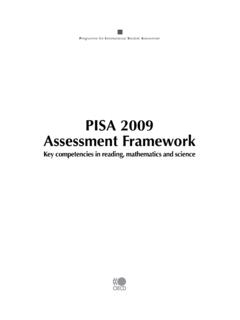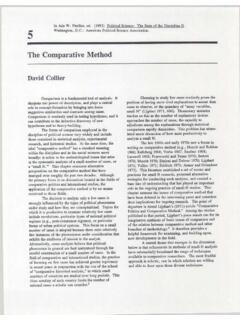Transcription of A Closer Look: An Individualized ... - Child Welfare
1 March 2008 A Closer look An Individualized , Strengths-Based Approach in Public Child Welfare Driven Systems of Care If we ask people to look for deficits, they will usually find them, and their view of the situation will be colored by this. If we ask people to look for successes, they will usually find them, and their view of the situation will be colored by this. (Kral, 1989, p. 32)Overview Among the strategies that are critical for increasing the safety, permanency, and well-being of children and families involved with Child Welfare is tailoring services to unique needs by building upon strengths. As Child Welfare agency administrators and policy-makers continually strive to improve services and outcomes for children and families, establishing Child Welfare policies and practices that promote and facilitate an Individualized , strengths-based approach is essential.
2 Policy is crucial to sustaining strengths-based practices, because without it such practices may be inconsistently applied and diminish with staff turnover. Defining an Individualized , Strengths-Based Approach An Individualized , strengths-based approach refers to policies, practice methods, and strategies that identify and draw upon the strengths of children, families, and communities. Strengths-based practice involves a shift from a deficit approach, which emphasizes problems and pathology, to a positive partnership with the family. The approach acknowledges each Child and family s unique set of strengths and challenges, and engages the family as a partner in developing and implementing the service plan.
3 Formal and informal services and supports are used to create service plans based on specific needs and strengths, rather than fitting families into pre-existing service plans. An Individualized , Improving Child Welfare Outcomes Through Systems of Care In 2003, the Children s Bureau funded nine demonstration grants to test the efficacy of a systems of care approach to improving outcomes for children and families involved in the Child Welfare system and to address policy, practice, and cross-system collaboration issues raised by the Child and Family Services Reviews. Specifically, this initiative is designed to promote infrastructure change and strengthen the capacity of human service agencies to support families involved in public Child Welfare through a set of six guiding principles: 1.
4 Interagency collaboration;2. Individualized , strengths-based care;3. Cultural and linguistic competence;4. Child , youth, and family involvement;5. Community-based services, and;6. Closer Look is a series of shor t repor ts that spotlight issues addressed by public Child Welfare agencies and their partners in implementing systems of care approaches to improve services and outcomes for children and families. These repor ts draw on the experiences of nine communities par ticipating in the Children s Bureau s Improving Child Welfare Outcomes Through Systems of Care demonstration initiative, and summarize their challenges, promising practices, and lessons learned.
5 Each issue of A Closer Look provides information communities nationwide can use in planning, implementing, and evaluating effective Child Welfare driven systems of care, and is intended as a tool for administrators and policy-makers leading system change initiatives. The National Technical Assistance and Evaluation Center wishes to thank the following family leaders and agency practitioners for their contributionsto the development of this resource: Rebecca Huffman, Sharri Black, Aaron Bianco, Ed Cohen, and Lynn Usher. strengths-based assessment focuses on the complex interplay of risks and strengths among individual family members, the family as a unit, and the broader neighborhood and environment.
6 The Individualized , strengths-based approach is an overall philosophical view supported by policies and standards that encompasses a range of concrete practices of Child Welfare caseworkers and other service providers at various points from the time the Child and family enter the system to when they leave (see Figure 1). Historically, Child Welfare systems (and other human services) emphasized efficient provision of services with little attention to family systems and approached clients from a deficit model. Traditional practices, focusing on what was wrong with the Child or the family, resulted in a Child Welfare system that was punitive and stigmatizing in its approach and often produced passive and resistant responses from clients (Waldfogel, 2000).
7 Beginning in the early 1980s, strengths-based case management was first implemented in community mental health centers (Brun & Rapp, 2001) and since then has been implemented in many other health and social service settings. A review of the literature suggests at least three pathways by which strengths-based practices benefit clients: 1) by influencing the extent of clients engagement inprogram services; 2) by increasing family efficacy and empowerment; and 3) by enhancing families relationship-Figure 1. Individualized , strengths-Based Approach and Practices Investigations Assessments Policy development Service provision and referrals Staff trainingOngoing case management Documentation in case records Individualized , STRENGTHS-BASED APPROACH PRACTICES building capacity and social support networks (Green, McAllister, & Tarte, 2004).
8 Although there is limited research on the effects of an Individualized , strengths-based approach on Child and family outcomes for the population of Child Welfare clients, prior studies of other service recipients ( , early intervention, mental health, elderly services) have found that a family-centered, strengths-based approach is associated with increased service engagement (Green et al., 2004; Shireman, 1998), increased parenting competency (Green et al., 2004; Whitley, 1999), and enhanced interaction among family members (Green et al., 2004; Huebner, Jones, Miller, Custer, & Critchfield, 2006). Individualized , Strengths-Based Approaches in a Child Welfare Driven System of Care An Individualized , strengths-based approach to working with families embodies important principles of Child Welfare practice promoted by the Children s Bureau Child and Family Services Review process.
9 The Child and Family Services Reviews were designed to support key practice principles, including tailoring interventions to meet the specific needs of children and families; offering children and families opportunities to provide input into the identification of their strengths, needs, and goals; and promoting parents strengths by emphasizing partnership with service providers. These principles are designed to support improved outcomes for children and families. The Child and Family Services Review process also focuses on two other systems of care principles that are closely related to Individualized , strengths-based approaches: family involvement and cultural competency.
10 An Individualized , strengths-based approach depends on collaboration between the service provider and client, in which individuals and families are viewed as equal partners in the change process. (See also A Closer Look: Family Involvement in Public Child Welfare Driven Systems of Care at www. ). Cultural competency is a A Closer look An Individualized , Strengths-Based Approach in Public Child Welfare Driven Systems of Care 2 prerequisite for implementing an Individualized , strengths-based approach because individuals from different cultural backgrounds may hold different values and make different judgments about how strengths are defined and the types of interactions that communicate respect.

















